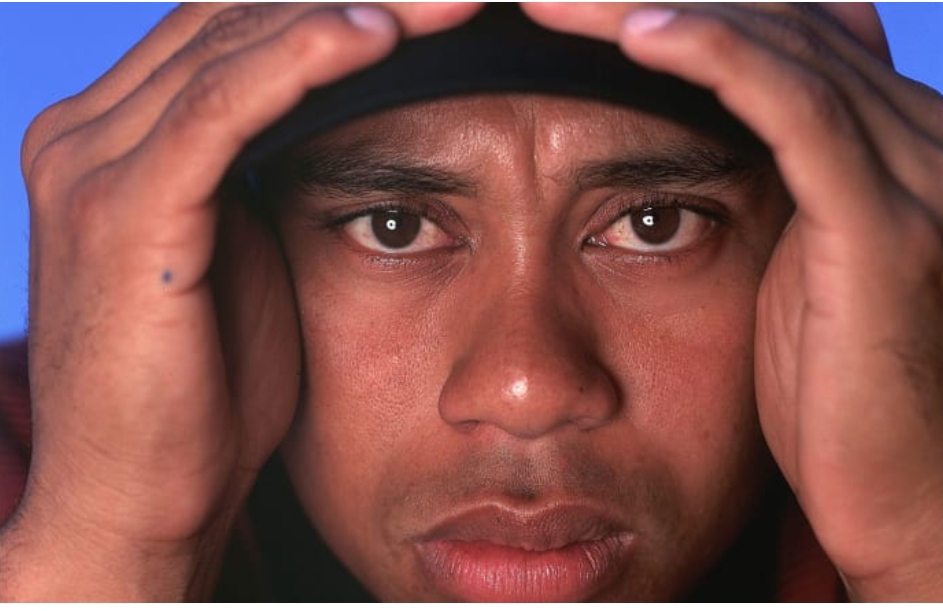TIGER WOODS HAS PARED DOWN HIS LIFE SO THAT HE CAN FOCUS—AND HE’S DOMINATING THE……,….

TIGER WOODS HAS PARED DOWN HIS LIFE SO THAT HE CAN FOCUS—AND HE’S DOMINATING THE GAME LIKE NO PLAYER BEFORE HIM
The last time it happened, his son stood over the ball on a blistering Sunday at Medinah (Ill.) Country Club. Sergio Garcia, young and eager, threatened disaster from just one stroke back. Tiger Woods held the lead at the 1999 PGA Championship, but his putter had let him down again and again. For once he looked vulnerable. Eight feet from the cup on 17 now. Holing the par putt would erase the pressure, would virtually clinch the victory. His second major. His reputation intact.
Tiger stood over the ball. He heard the voice of his father, Earl, high and hollow, sounding in his head. He didn’t know where it was coming from. Memory? Fear? Earl insists that he can do this anytime, talk to his son when he’s on the other side of the course, talk to him through a television set all the way at the other end of the earth. Earl did it that day from his hotel room in Chicago, softly speaking to his son’s image as it glowed on the screen: Tiger. This is a must-make putt. Trust your stroke. Trust your stroke.
Tiger heard, trusted, sent the ball rolling. It dropped into history. That night at the victory party, Tiger smiled at Earl and said, “I heard you, Pop.”
The first time it happened, Tiger was 12. San Diego, junior world championships, final hole: He hit an approach shot over the green, needed to get up and down for the win. Earl, standing behind the green where Tiger couldn’t see him, began muttering to himself, Don’t do anything stupid. Put the ball on the green and trust your putting. Tiger pitched, putted, won. He came sprinting over the grass, yelling, “I heard you, Daddy! I heard you!”
“That’s when we knew,” Earl says. “He knows where I am at all times.”
Everything bends to him now. Parents, opponents, friends, interviewers, tour flacks, sponsors, tour directors, TV networks–all wait for Tiger to make the call. All hope he will give a minute, pay them just a little more attention, but they understand if he can’t, and they wait some more. Greatness gives you power, and power allows you to control your world, and if your world keeps expanding beyond the wealthy little fiefdom of professional golf and into the mad plastic nation of pure celebrity, so be it. Woods is 24 years old and the biggest, richest, most powerful athlete in his game. He doesn’t worry about money. He doesn’t worry about what people think. His greatness has set him free.
Last fall, during a Ryder Cup practice round, Woods and Tom Lehman were playing alternate shots—one teed off on the odd holes, the other on the even—and Woods stood waiting for Lehman to tee up on the sixth. A fan with a thick Boston accent rasped, “Come on, Tigah! Hit one!” Woods stared into space. “Hit a ball, Tigah! Come on!” Woods waited for Lehman to drive and then strolled away. “Hit one for me, Tigah!” Woods didn’t turn, wave, shrug. Nothing. Finally, here it came: “Tigah! You suck!”
“You get that a lot?” Lehman asked.
“Every day,” Woods said.
“Most guys, it’d bother them or piss them off, but with Tiger it’s just water off a duck’s back,” Lehman says. “It didn’t even faze him.”
Almost nothing does. Even the stresses of sport, the pressure that made Roger Maris’s hair fall out in clumps, hold little power over Woods. He doesn’t crack. He doesn’t blow leads. When, last fall and winter, he captivated the country by winning six straight PGA Tour events, churning up talk about his breaking Byron Nelson’s unbreakable record of 11 consecutive tournament victories, Woods showed no sign of noticing, much less wilting under, the mushrooming mania. That’s because he found what everyone else considered astounding to be bogus. He’d lost a non-Tour event during the streak, so while his peers marveled and the scribes oohed and aahed, Woods had no use for any of it. “That wasn’t a streak,” he says. “I look at a streak as I don’t lose—literally.”
Such exactitude can be deflating to his admirers, but Woods’s ambition leaves him no choice. He has won 18 Tour events in his 3 1/2 years as a pro, gathered $45 million in endorsements and already set the record for career winnings with $14.5 million, but to him those are mere numbers. He sets for himself a higher standard–he wants to be, simply, the greatest golfer of all time–and he rightly regards himself as not only the one proper custodian of his game but also its only bona fide judge. Woods doesn’t care what a fan or some bloated golf writer or the average former pro with a microphone says. He doesn’t need what they have to give.
This is cold, but who’s going to argue? Woods broke the tournament records for 72-hole score (270) and margin of victory (12 strokes) at the Masters in 1997 and won that PGA at Medinah for his other major, staying roughly even with his Moby-Dick, Jack Nicklaus, at the same point in their careers. Woods’s unique stature has forced a revolution that now washes over every corner of the pro game: Everyone in golf has been obliged to adjust to the fact that because Tiger rules, there are plenty of Tiger Rules. Tournament security has been beefed up. Tiger never commits to an event until the last minute. But few complain: Ratings skyrocket whenever he plays; purses have just about doubled in the last four years largely because of his soaring popularity; Nike’s golf division has grown from $100 million to $250 million since Tiger signed a contract with the company four years ago. “We all ought to be thankful he’s out here,” says Tour veteran Steve Pate. “Because of him we’re playing for a helluva lot more money.”
Fat times always make it easier for subjects to bow their heads, but having his ring kissed has interested Woods far less than exercising suzerainty over his court. After several missteps following his leap onto the Tour in 1996, he has seized control of the career once steered by his father–the chain of command now begins and ends with Tiger–and purged everyone from the original Team Tiger except swing coach Butch Harmon. One by one they found themselves outside looking in: sports psychologist Jay Brunza (who retains a position on the board of the Tiger Woods Foundation), lawyer John Merchant, agent Hughes Norton and, last year, celebrated caddie Mike (Fluff) Cowan. In all cases, Woods father and son say, Tiger made the decision to cut the associate loose (though Merchant says he was fired by Earl). “I haven’t talked to Tiger since,” says Merchant of his dismissal in December 1996, after several years as an adviser to Earl and five months as Tiger’s lawyer. “I was puzzled by it. But lawyers come and go, so I got out of Dodge.”
The firings came for different and, perhaps, understandable reasons. Brunza, a Navy captain who caddied for Tiger when Tiger was in the juniors, carried his bag less once Tiger went off to Stanford. As for Cowan, caddies have about as much job security as migrant workers. Many observers note, however, that Cowan, Merchant and Norton all shared the fatal flaws of being older than Tiger and having outsized personalities that didn’t jibe with his reserved style. The dismissals had a chilling finality. “Very tough, unemotional, very cold,” says one longtime Tiger watcher. “With all his money and achievement, it won’t matter, but there’s this total lack of loyalty to anybody. Brunza, Merchant, Norton, Cowan—dumped. And Butch Harmon…someday. Tiger coldly cuts through and moves on.”
Woods explains the firings vaguely: “You just want a better fit, just want things a little bit better.” But if his off-course ruthlessness is merely a way to keep things simple, it dovetails with his on-course reputation for hammering opponents into the turf–“stepping on the neck,” as the Woods family so delicately puts it. Yet Woods has also learned how to handle his dominance with grace. After Rocco Mediate fended off Woods and Justin Leonard in the final round to win the 1999 Phoenix Open (Mediate’s first win in six years, including an absence from the Tour for the better part of two years for major back surgery), he was stunned when Woods approached him and whispered, “Glad to have you back.”
In February, on the day her son gutted Michael Campbell 5 and 4 in the opening round of the Andersen Consulting Match Play Championship at La Costa in Carlsbad, Calif., leaving a carcass where the winter’s second-hottest golfer once stood, Kultida Woods sat on a couch outside the locker room. Suddenly a player stuck a hand in front of her. “My name is Olin Browne,” he said. “I played with Tiger at the Sprint International last year, just after he won the PGA, and I wanted to tell you that you raised a good man. He’s a good man.” Browne walked off. Tida beamed.
“This is what a mother loves to hear,” she said. Tida went on to tell how she was the law in the house when Tiger was growing up in the Los Angeles suburb of Cypress; how she told him, “You will never, never ruin my reputation as a parent, because I will beat you”; how she–not her Vietnam-veteran husband–was the one who instilled in Tiger a cutthroat approach to the game. “I said, ‘Go after them, kill them,'” Tida said, her English weighted by a heavy Thai accent. “‘When you’re finished, now it’s sportsmanship. Before that, go for that throat. Don’t let your opponent up.'”
Told that Earl says he would like Tiger to develop a more tender side as his career moves along, Tida laughed. “That’s Dad,” she said. “Dad wants him to be more compassionate. He’s Green Beret and all, but he’s more compassionate than I am. Tiger’s personality is more like mine than Dad’s.” Asked if that also applies off the course, Tida nodded. “When Tiger says no, don’t ever go ask him again–that’s it,” she said. “When he moves along, out, he won’t come back. He’s more like Mom: When I say ‘Enough,’ don’t ever come ask me again. I cut and move on. Tiger’s more like me.”
On TV, of course, golf still comes off as a whispering game, sports’ last haven of leafy refinement. But when Tiger joined the field at the Nissan, in February, the crowd milling about the moneyed Riviera Country Club gave off the stink of a liquored-up circus. Following a trend seen earlier in the season at tournaments in Phoenix and Pebble Beach, an alarming number of seemingly average folks became so inebriated that they struggled simply to assemble coherent sentences. Most didn’t wait for Woods’s group to hole out; once Tiger was finished, they loudly scrambled to the next tee. On Sunday one red-faced man frolicked about in a Tigger costume. When Woods arrived on the green at 13, one of the half-dozen security men following him grabbed a colleague and said, “See that woman in the big fur hat, yellow, looks like a bumblebee? What’s she carrying?” Later, a moment after Woods had passed by on his way to the locker room, a slack-faced man sitting on the clubhouse steps unleashed a proud trumpet blast of flatulence. No one in the throng reacted with anything resembling surprise.
This is part of the change Woods has wrought in golf, delivering with his personality and prowess a crowd that has little knowledge of the game’s traditions or etiquette. “It’s changing, and I like the way it’s going, the way kids are getting involved,” Woods says, “but it’s up to the adults to educate these kids and not get belligerently drunk on the course and mouth off. It’s a double-edged sword: You want everybody to participate, but not everyone who comes out is a golfer. You get some fans who are football fans, hockey fans, basketball fans who like to do other things on the golf course.”
Yet drawing in such fans is the mission of any sport, and no one is doing that better than Woods. Even tournaments in which he doesn’t play have seen a surge in gate receipts and sponsorship revenues over the last two years. PGA Tour commissioner Tim Finchem’s ambition is for golf “to challenge to become one of the premier mass sports,” to draw in the casual fan and the young minority audience that has been flocking to football and basketball. It’s getting there. If Finchem or his NBA counterpart, David Stern, is seeking a line of demarcation between eras–the day that cool seeped out of one sport and into another–he need look no further than Sunday, Feb. 13. Woods’s final round at the Buick International, in which he was gunning for his seventh straight Tour win, pulled in an 8.0 television rating, easily surpassing the 6.9 earned by the NBA All-Star Game that night. “The NBA All-Stars? Are you kidding me?” Mediate says. “This is golf we’re talking about.”
No, this is Tiger, quickly assuming the iconic status accorded to Michael Jordan. The number staggers the imagination: When Woods plays, the TV audience rises by as much as 40% above the average for tournaments he skips. “Everybody was looking for the next Michael, and they were always looking on the basketball court,” Nike chairman Phil Knight says. “He was walking down the fairway.”
Not since Mike Tyson rampaged across the go-go 1980s has a sports figure so perfectly reflected an era. In Woods, America at the millennium has found its embodiment. This is the age, after all, of twentysomething dot.commandos, of billionaires in T-shirts, of an older generation overwhelmed by a horde of young, smart, so-rich-so-fast workaholics. Who better to represent their world than a Stanford-educated, multiracial champion who, just when you thought he’d reached his peak (last year Woods won eight titles, led the Tour in five of 10 statistical categories and made almost twice as much prize money as his nearest competitor), keeps getting better? Heading into next week’s Masters, Woods has won three tournaments in 2000 and, equally impressive, has been in position to win in the final rounds of three of the other four events he has played in.
“People said he was long but too wild, and he’s become the best driver in the game,” Harmon says. “They said he couldn’t control his short irons because he swung too hard, said his wedge play wasn’t any good. Now they’re the strengths of his game because Tiger has worked. He hit 71 percent of his fairways last year; he led the Tour in hitting greens in regulation. He has got to putt more consistently, but when he putts well, he’s phenomenal. He’s a work in progress. Anything that’s a weakness, he turns into a strength.”
It’s Woods’s ability to identify and eliminate any frailty that makes him so daunting an opponent. Behind the dazzling smile lies the ultimate killer ap: Woods is the sporting equivalent of the iMAC, a multicolored (black, white, red and yellow) package with a cute nickname, state-of-the-art design and a Terminator software package that leaves the competition dazed and confused. “He’s not human,” says Mediate. “Cut him open, and I’ll tell you what you’ll find: a bunch of wires and levers, and a big-assed heart.”
To compensate, golfers everywhere are shedding pounds faster than bad English gamblers–and putting on muscle. Woods’s mysterious weight-training regimen, about which he refuses to divulge details, even to his father, has packed 20 pounds of muscle onto his once-willowy frame and sent guys such as David Duval into programs that have left them looking ripped. “I’m really making an effort to get stronger,” says Jesper Parnevik. “It’s all Tiger’s fault.”
For the first time, one golfer is so dominant that he’s never out of a tournament. Woods hasn’t missed a cut since 1998, and he has climbed inside the skull of every other player on the Tour. “When Tiger turned pro, he said, ‘I expect to win every time,’ and everybody was like, ‘Yeah, right, sure,'” Lehman says. “He’s made you realize he means it. So how does that affect me? It changes my mind-set. If I don’t expect to win every time, how can I expect to compete? I need to learn what he’s learned. I’d better trust in my talent, I’d better believe in myself under the gun, and I’d better expect to win.”





